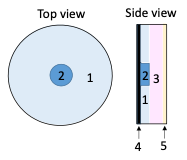Semiconductors
Highly efficient UV LEDs
Beryllium doped GaN Semiconductors to create extremely bright LEDs
UV LEDs have seen tremendous growth in the past decade. Application areas include sterilization of biological environments for research purposes, counterfeit detection, industrial curing of resins, coatings, and inks, and water purification. Traditional and the most widely used method of manufacturing UV lights is by mercury-based lamps, these methods are ecologically damaging and can pose health and safety risks. Moreover, these methods are expensive and inefficient, ~30% per 100 Watts. Semiconductors have become widely used to produce LEDs, and Aluminum Gallium Nitride (AlGaN) is one of the most common materials to produce UV LEDs. Magnesium has been the most common dopant to obtain p-type conductivity in these GaN-based semiconductors. However, the current efficiency of Mg-based UV LEDs is very low.
The technology
VCU researchers have developed a new method to produce highly conductive p-type GaN and AlGaN semiconductors using beryllium as a dopant, while also reducing the formation of unwanted defects seen in previous methods of beryllium doping. This novel method reduces the ionization energy required to produce UV light, increasing the efficiency and brightness per watt; compared to the currently available most efficient Mg-doped GaN and AlGaN semiconductors. Furthermore, using this method the researchers have proposed a concept of ultrabright multilayer UV LED to further increase the efficiency of the light produced by this device. The modification includes a Mg-doped AlGaN region acting as a starter for more efficient Be-doped AlGaN-based UV LED.

Figure 1. The structure of a bright UV LED. 1 – Be-doped AlGaN, 2 – Mg-doped AlGaN, 3 – Si-doped AlGaN, 4 – metal contact, 5 – transparent oxide contact.
